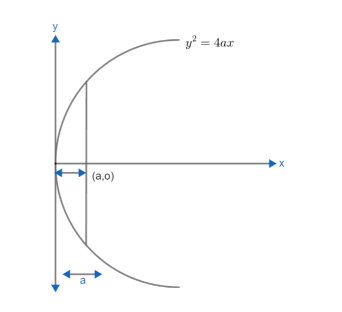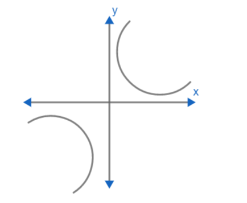
If the curves $ {{y}^{2}}=4ax\text{ and xy=}{{\text{c}}^{\text{2}}}, $ cut orthogonally then $ {{c}^{2}}=32{{a}^{4}} $
Answer
580.8k+ views
Hint: Assume any arbitrary point of intersection of parabola $ {{y}^{2}}=4ax $ and hyperbola $ \text{xy=}{{\text{c}}^{\text{2}}} $ as $ P({{x}_{1}},{{y}_{1}}) $ Find the slopes of both curves at point $ P({{x}_{1}},{{y}_{1}}) $ as $ {{m}_{1}}\text{ and }{{\text{m}}_{\text{2}}} $ then with the help of orthogonality condition $ {{m}_{1}}\times {{\text{m}}_{\text{2}}}=-1 $ give the proof.
Complete step-by-step answer:
We have a parabola $ {{y}^{2}}=4ax $ and a hyperbola $ \text{xy=}{{\text{c}}^{\text{2}}} $ cutting each other orthogonally or perpendicularly.

\[\begin{align}
& {{y}^{2}}=4ax \\
& \text{Focus at (a,o)} \\
\end{align}\]

\[\text{Hyperbola: yx=}{{\text{c}}^{\text{2}}}\]
Intersection of above two curves:

Suppose, they intersect at $ P({{x}_{1}},{{y}_{1}}) $ orthogonally.
Then, the tangent at point $ P({{x}_{1}},{{y}_{1}}) $ to both the curves should be $ {{\bot }^{r}} $ (perpendicular) to each other.
\[\Rightarrow {{T}_{1}}{{\bot }^{r}}{{T}_{2}}\]
Let’s suppose the shape of tangent line $ {{T}_{1}} $ is $ {{m}_{1}} $ and slope of tangent line $ {{T}_{2}} $ is $ {{m}_{2}} $ at point $ P({{x}_{1}},{{y}_{1}}) $
According to orthogonal condition:
\[\Rightarrow {{m}_{1}}\times {{\text{m}}_{\text{2}}}=-1\]
Thus, we find the slope of both the tangents through their curve.
$ {{T}_{1}} $ corresponds to curve $ {{y}^{2}}=4ax $
Slope $ {{m}_{1}} $ is nothing but $ \dfrac{dy}{dx} $ therefore, differentiating $ {{y}^{2}}=4ax $ with respect of x.
\[\begin{align}
& \Rightarrow 2y\dfrac{dy}{dx}=4a \\
& \Rightarrow \dfrac{dy}{dx}=\dfrac{2a}{y}\Rightarrow {{m}_{1}}=\dfrac{2a}{y} \\
\end{align}\]
\[{{m}_{1}}\text{ at point }P({{x}_{1}},{{y}_{1}})\Rightarrow {{m}_{1}}=\dfrac{2a}{{{y}_{1}}}\text{ }\text{. }\text{. }\text{. }\text{. }\text{. }\text{. }\text{. }\text{. }\text{. }\text{. }\text{. }\text{. }\text{. (1)}\]
Now, $ {{T}_{2}} $ corresponds to curve $ \text{xy=}{{\text{c}}^{\text{2}}} $
Therefore,
\[{{m}_{2}}\Rightarrow \dfrac{d}{dx}\left( xy \right)=\dfrac{d}{dx}\left( {{c}^{2}} \right)\]
Applying chain rule of product here for differentiating $ \dfrac{d}{dx}\left( xy \right) $
\[\begin{align}
& \dfrac{d}{dx}\left( xy \right)=y\times \dfrac{d\left( x \right)}{dx}+x\times \dfrac{d\left( y \right)}{dx} \\
& \Rightarrow \dfrac{d}{dx}\left( xy \right)=y+\dfrac{xdy}{dx} \\
\end{align}\]
So,
\[y+\dfrac{xdy}{dx}=\dfrac{d}{dx}\left( {{c}^{2}} \right)\]
Since, $ {{c}^{2}} $ is a constant, so the derivative of this unit x would be zero.
\[\begin{align}
& \Rightarrow y+x\left( \dfrac{dy}{dx} \right)=0 \\
& \Rightarrow \dfrac{xdy}{dx}=-y \\
& \Rightarrow \dfrac{dy}{dx}=\dfrac{-y}{x}\Rightarrow {{m}_{2}}=\dfrac{-y}{x} \\
\end{align}\]
\[{{m}_{2}}\text{ at point }P({{x}_{1}},{{y}_{1}})\Rightarrow {{m}_{2}}=\dfrac{-{{y}_{1}}}{{{x}_{1}}}\text{ }\text{. }\text{. }\text{. }\text{. }\text{. }\text{. }\text{. }\text{. }\text{. }\text{. }\text{. }\text{. }\text{. (2)}\]
From equation (1) and (2) we have:
\[{{m}_{1}}=\dfrac{2a}{{{y}_{1}}}\text{ , }{{\text{m}}_{\text{2}}}=\dfrac{-{{y}_{1}}}{{{x}_{1}}}\]
But \[{{m}_{1}}\times {{\text{m}}_{\text{2}}}=-1\]
\[\Rightarrow \dfrac{2a}{{{y}_{1}}}\text{ }\times \dfrac{-{{y}_{1}}}{{{x}_{1}}}=-1\Rightarrow {{x}_{1}}=2a\]
Putting the value of $ {{x}_{1}} $ from any of the curve to get value of $ {{y}_{1}} $
\[\begin{align}
& y_{1}^{2}=4a{{x}_{1}}\Rightarrow y=\sqrt{4a{{x}_{1}}}\Rightarrow {{y}_{1}}=\sqrt{4a\times 2a} \\
& \Rightarrow {{y}_{1}}=\sqrt{8{{a}^{2}}} \\
\end{align}\]
Now, we have $ {{x}_{1}}=2a\text{ and }{{y}_{1}}=\sqrt{8a} $
Putting values of $ {{x}_{1}}\text{ and }{{\text{y}}_{\text{1}}} $ in curve $ \text{xy=}{{\text{c}}^{\text{2}}} $ we will get the relation between c, a.
So, \[xy={{c}^{2}}\Rightarrow {{x}_{1}}{{y}_{1}}={{c}^{2}}\]
\[\Rightarrow 2a\times \sqrt{8a}={{c}^{2}}\]
Squaring both the sides
\[\begin{align}
& \Rightarrow {{\left( 2a\times \sqrt{8a} \right)}^{2}}={{c}^{4}} \\
& \Rightarrow 32{{a}^{4}}={{c}^{4}} \\
\end{align}\]
Hence proved $ {{c}^{4}}=32{{a}^{4}} $
Note: Geometric representation of the curve is given for better understanding, students must not waste their time imagining the actual scenario instead proceed to the solution as per the orthogonality condition.
Complete step-by-step answer:
We have a parabola $ {{y}^{2}}=4ax $ and a hyperbola $ \text{xy=}{{\text{c}}^{\text{2}}} $ cutting each other orthogonally or perpendicularly.

\[\begin{align}
& {{y}^{2}}=4ax \\
& \text{Focus at (a,o)} \\
\end{align}\]

\[\text{Hyperbola: yx=}{{\text{c}}^{\text{2}}}\]
Intersection of above two curves:

Suppose, they intersect at $ P({{x}_{1}},{{y}_{1}}) $ orthogonally.
Then, the tangent at point $ P({{x}_{1}},{{y}_{1}}) $ to both the curves should be $ {{\bot }^{r}} $ (perpendicular) to each other.
\[\Rightarrow {{T}_{1}}{{\bot }^{r}}{{T}_{2}}\]
Let’s suppose the shape of tangent line $ {{T}_{1}} $ is $ {{m}_{1}} $ and slope of tangent line $ {{T}_{2}} $ is $ {{m}_{2}} $ at point $ P({{x}_{1}},{{y}_{1}}) $
According to orthogonal condition:
\[\Rightarrow {{m}_{1}}\times {{\text{m}}_{\text{2}}}=-1\]
Thus, we find the slope of both the tangents through their curve.
$ {{T}_{1}} $ corresponds to curve $ {{y}^{2}}=4ax $
Slope $ {{m}_{1}} $ is nothing but $ \dfrac{dy}{dx} $ therefore, differentiating $ {{y}^{2}}=4ax $ with respect of x.
\[\begin{align}
& \Rightarrow 2y\dfrac{dy}{dx}=4a \\
& \Rightarrow \dfrac{dy}{dx}=\dfrac{2a}{y}\Rightarrow {{m}_{1}}=\dfrac{2a}{y} \\
\end{align}\]
\[{{m}_{1}}\text{ at point }P({{x}_{1}},{{y}_{1}})\Rightarrow {{m}_{1}}=\dfrac{2a}{{{y}_{1}}}\text{ }\text{. }\text{. }\text{. }\text{. }\text{. }\text{. }\text{. }\text{. }\text{. }\text{. }\text{. }\text{. }\text{. (1)}\]
Now, $ {{T}_{2}} $ corresponds to curve $ \text{xy=}{{\text{c}}^{\text{2}}} $
Therefore,
\[{{m}_{2}}\Rightarrow \dfrac{d}{dx}\left( xy \right)=\dfrac{d}{dx}\left( {{c}^{2}} \right)\]
Applying chain rule of product here for differentiating $ \dfrac{d}{dx}\left( xy \right) $
\[\begin{align}
& \dfrac{d}{dx}\left( xy \right)=y\times \dfrac{d\left( x \right)}{dx}+x\times \dfrac{d\left( y \right)}{dx} \\
& \Rightarrow \dfrac{d}{dx}\left( xy \right)=y+\dfrac{xdy}{dx} \\
\end{align}\]
So,
\[y+\dfrac{xdy}{dx}=\dfrac{d}{dx}\left( {{c}^{2}} \right)\]
Since, $ {{c}^{2}} $ is a constant, so the derivative of this unit x would be zero.
\[\begin{align}
& \Rightarrow y+x\left( \dfrac{dy}{dx} \right)=0 \\
& \Rightarrow \dfrac{xdy}{dx}=-y \\
& \Rightarrow \dfrac{dy}{dx}=\dfrac{-y}{x}\Rightarrow {{m}_{2}}=\dfrac{-y}{x} \\
\end{align}\]
\[{{m}_{2}}\text{ at point }P({{x}_{1}},{{y}_{1}})\Rightarrow {{m}_{2}}=\dfrac{-{{y}_{1}}}{{{x}_{1}}}\text{ }\text{. }\text{. }\text{. }\text{. }\text{. }\text{. }\text{. }\text{. }\text{. }\text{. }\text{. }\text{. }\text{. (2)}\]
From equation (1) and (2) we have:
\[{{m}_{1}}=\dfrac{2a}{{{y}_{1}}}\text{ , }{{\text{m}}_{\text{2}}}=\dfrac{-{{y}_{1}}}{{{x}_{1}}}\]
But \[{{m}_{1}}\times {{\text{m}}_{\text{2}}}=-1\]
\[\Rightarrow \dfrac{2a}{{{y}_{1}}}\text{ }\times \dfrac{-{{y}_{1}}}{{{x}_{1}}}=-1\Rightarrow {{x}_{1}}=2a\]
Putting the value of $ {{x}_{1}} $ from any of the curve to get value of $ {{y}_{1}} $
\[\begin{align}
& y_{1}^{2}=4a{{x}_{1}}\Rightarrow y=\sqrt{4a{{x}_{1}}}\Rightarrow {{y}_{1}}=\sqrt{4a\times 2a} \\
& \Rightarrow {{y}_{1}}=\sqrt{8{{a}^{2}}} \\
\end{align}\]
Now, we have $ {{x}_{1}}=2a\text{ and }{{y}_{1}}=\sqrt{8a} $
Putting values of $ {{x}_{1}}\text{ and }{{\text{y}}_{\text{1}}} $ in curve $ \text{xy=}{{\text{c}}^{\text{2}}} $ we will get the relation between c, a.
So, \[xy={{c}^{2}}\Rightarrow {{x}_{1}}{{y}_{1}}={{c}^{2}}\]
\[\Rightarrow 2a\times \sqrt{8a}={{c}^{2}}\]
Squaring both the sides
\[\begin{align}
& \Rightarrow {{\left( 2a\times \sqrt{8a} \right)}^{2}}={{c}^{4}} \\
& \Rightarrow 32{{a}^{4}}={{c}^{4}} \\
\end{align}\]
Hence proved $ {{c}^{4}}=32{{a}^{4}} $
Note: Geometric representation of the curve is given for better understanding, students must not waste their time imagining the actual scenario instead proceed to the solution as per the orthogonality condition.
Recently Updated Pages
Master Class 12 English: Engaging Questions & Answers for Success

Master Class 12 Business Studies: Engaging Questions & Answers for Success

Master Class 12 Economics: Engaging Questions & Answers for Success

Master Class 12 Social Science: Engaging Questions & Answers for Success

Master Class 12 Maths: Engaging Questions & Answers for Success

Master Class 12 Chemistry: Engaging Questions & Answers for Success

Trending doubts
What are the major means of transport Explain each class 12 social science CBSE

Which are the Top 10 Largest Countries of the World?

Draw a labelled sketch of the human eye class 12 physics CBSE

Explain sex determination in humans with line diag class 12 biology CBSE

The pH of the pancreatic juice is A 64 B 86 C 120 D class 12 biology CBSE

Explain sex determination in humans with the help of class 12 biology CBSE




